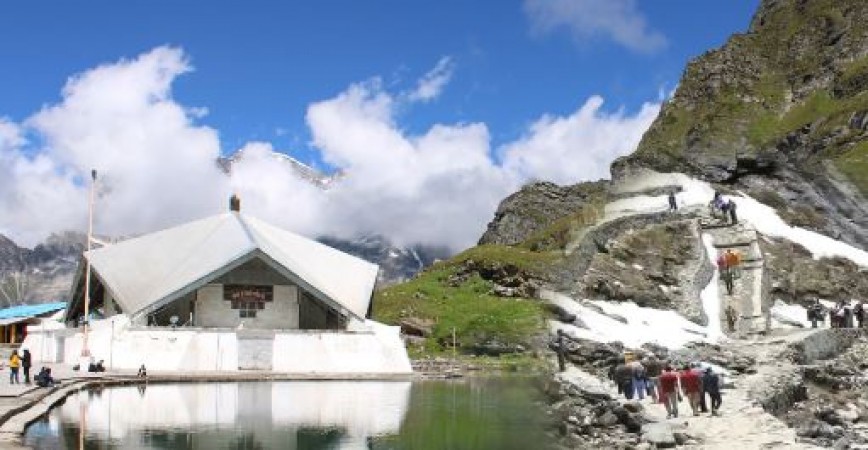
Gurudwara Sri Hemkund Sahib is situated at an altitude of around 4,329m. It is located in the Chamoli district of Uttarakhand near the Valley of the Flower. This holy shrine got its name from the glacial lake Hemkund, adjacent to the Gurudwara whose literal meaning is Lake Of Snow.
It is devoted to Dasam Granth who is the tenth guru Sri Guru Gobind Singh Ji where he mediated intensely at Hemkund in Akaal. Hemkund is a Sanskrit word derived from Hem meaning Snow and Kund meaning Bowl. The glacial lake is surrounded by Seven mountain peaks each adorned by Nishan Sahib which is a Khalsa Flag on its cliff.
Sikhs started looking for Hemkunt, a location in the Himalayan Mountains that their tenth Guru mentioned in the autobiographical Bachitra Natak, in the late eighteenth century. The phrase "wonderful drama" basically translates as the title of this piece. The Dasam Granth, a collection of literature attributed to Guru Gobind Singh, contains it.
Ab Mai Katha Bakhano
Tab Sadhat Jih Bidh Mudano
Hemkunt Parbat Hai Jaha
Sapatsring Sobhit Hai Taha
In these poetic verses, the Guru tells of his origins. He describes the place Hemkund Parbat Sapat Sring the ‘Lake of Ice’ mountain adorned with seven peaks as the same place where King Pandu the forefather of the five Pandava brothers of Mahabharata practiced Yoga. There Guru did intense meditation and austerities until he merged with god.
Also Read:Punjab Assembly Approves Golden Temple's Free Gurbani Telecast Bill
The Sikhs' desire to build shrines to commemorate locations blessed by the tenth Guru's visit during his lifetime or, in the case of Hemkunt, during a prior lifetime, led to the search for and discovery of Hemkunt. The Dasam Granth featured Bachitra Natak somewhere in the 1730s, but it appears that Sikhs did not think about looking for Hemkunt Sapatsring until the late nineteenth century. It wasn't until the 20th century that it started to attract pilgrims.
Inspiration for building a larger gurdwara at Hemkunt came from a woman who was given the mission to lay its foundation stone in a vision of Guru Gobind Singh. When Mata Ram Kaur, a housewife from Punjab, presented herself in Gobind Ghat in 1960 and revealed her purpose, the management was skeptical. She was able to convince them of the sincerity of her mission by describing details of Hemkunt that, never having been there before, she had no way of knowing.
Gurudwara was designed with the image of an upside-down lotus flower in mind. The roof of the structure can withstand the weight of heavy winter snowfall, and doors on all five sides welcome visitors from every direction and every faith. The lower story was completed first. In a room in its center, the Guru Granth Sahib was installed beneath a brass canopy. Due to glaciers and snow-covered routes, Hemkund is inaccessible from October to April. When Sikh pilgrims arrive in May, they immediately get to work repairing the path's damage from the previous winter. This practice is known as kar seva ("selfless service") and is a key element of the Sikh faith.
Also Read:Char Dham Yatra 2023: Over 30 Lakh Pilgrims Embark on Spiritual Journey
The settlement of Govindghat, located around 275 kilometers (171 miles) from Rishikesh, serves as the departure point for Hemkund Sahib. The 9 km (5.6 mi) hike to the village of Ghangaria (also known as Govinddham) is along a largely well-maintained trail. This path can be traveled on foot or by pony, and a Gurudwara nearby offers pilgrims refuge. A campground with tents and beds is also there, along with a few motels. Hemkund is reached after a climb of 1,100 meters (3,600 feet) along a 6-kilometer (3.7 mi) long stone-paved path. Hemkund Sahib does not permit overnight stays, thus if you want to return to Govindghat by dusk, you must depart by 2 PM.
It is believed that the place once used to be a meditation ground for Lord Ram’s brother Lakshmana. A nearby temple dedicated to Lord Lakshmana can also visit there.
Hemkunt Sahib is significant to Sikhs because it is thought that Guru Gobind Singh, the 10th and last guru of the Sikh religion, meditated there before departing from his mortal body. The teachings of Guru Gobind Singh, a renowned leader, and educator, still motivate Sikhs today. Making the trek to Hemkund Sahib is a popular way for Sikhs to be in touch with their guru and obtain his blessings.
People take Ishnan which is taking a dip in holy water to wash away all their Sins. And meditate and do Path Sahib. People believe that there Sri Guru Gobind Singh Ji still meditates and visits there. The eagle of Guru Gobind Singh visits every day.
It is also a part of the Char Dham Yatra in Uttarakhand the holiest pilgrimage in India. The journey to visit Hemkund Sahib is long and difficult but it is also an incredible experience.
Also Read:Maharaja Ranjit Singh: First Maharaja of Sikh Empire